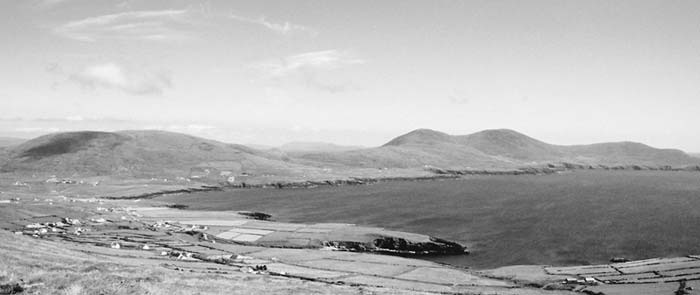
It’s no wonder that, since Victorian times, visitors have been attracted to this dramatic chunk of Ireland. Mysterious ancient ring forts stand sentinel on mossy hillsides. A beloved Irish statesman maintained his ancestral estate here, far from 19th-century power politics. And early Christian hermit-monks left a lonely imprint of their devotion, in the form of simple stone dwellings atop an isolated rock crag far from shore...a holy retreat on the edge of the then-known world.
Today, it seems like every tour bus in Ireland makes the ritual loop around the scenic Ring of Kerry, using the bustling and famous tourist town of Killarney as a springboard. Killarney National Park is gorgeous and well worth driving through. But I prefer to skip Killarney town (useful only for its transportation connections). Instead, make the tidy town of Kenmare your home base, and use my suggestions to cleverly circle the much-loved peninsula—entirely missing the convoy of tour buses.
Cradled in a lush valley, this charming little town (known as Neidín, or “Little Nest,” in Gaelic) hooks you right away with its rows of vividly colored shop fronts and go-for-a-stroll atmosphere. Its fresh appearance won it Ireland’s “Tidy Town” award in 2000, and the nearby finger of the gentle sea feels more like a large lake (called the Kenmare River, just to confuse things). Far from the assemblyline tourism of Killarney town, Kenmare (rhymes with “chair”) also makes a great launchpad for enjoying the sights along the road around the Iveragh (eev-er-AH) Peninsula—known to shamrock lovers everywhere as the Ring of Kerry.
All you need in compact Kenmare is one night and a couple of hours to wander the town. Check out the Heritage Centre (in the back rooms of the TI) to get an overview of the region’s history. Visit the Kenmare Lace and Design Centre (above TI, entry next door) to get a close look at its famously delicate lace. A five-minute walk from the TI gives you hands-on access to an ancient stone circle at the edge of town. Finish up by taking a peek inside Holy Cross Church to see the fine ceiling woodwork. Don’t stay out too late in the pubs if you’d like to get an early start on the Ring of Kerry in the morning.
Carefully planned Kenmare is shaped like an “X,” forming two triangles. The upper (northern) triangle contains the town square (colorful markets Wed and Fri in summer), the adjacent TI and Heritage Centre, and a cozy park. The lower (southern) triangle contains three one-way streets busy with shops, lodgings, and restaurants. Use the tall Holy Cross Church spire to get your bearings (next to the northeast parking lot). Public WCs across the street are vile...if possible, wait to use one wherever you settle for lunch.
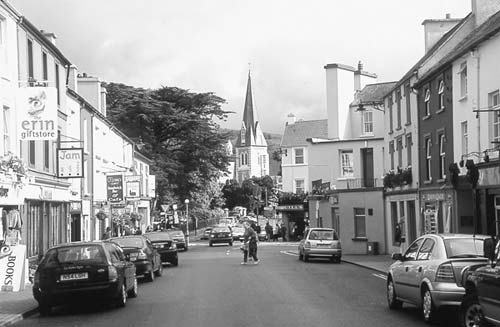
The helpful TI is on the town square (July-Aug daily 9:00-19:00; May-June and Sept Mon-Sat 9:30-17:00, closed Sun; closed Oct-April; tel. 064/664-1233).
Banking: Bank of Ireland faces the town square, and Allied Irish Bank takes up the corner of Henry and Main streets (both open Mon 10:00-17:00, Tue-Fri 10:00-16:00, closed Sat-Sun).
Internet Access: You’ll find three terminals inside the front window of Murphy’s Daybreak Supermarket on Main Street (€1.50/30 minutes), and another three in the post office (€2/30 minutes).
Post Office: It’s located on Henry Street, at the intersection with Shelbourne Street (Mon-Fri 9:00-17:30, Sat 9:00-13:00, closed Sun).
Laundry: O’Shea’s Cleaners and Launderette is across from the Lansdowne Arms Hotel, hidden in the back recesses of O’Shea’s photography shop (Mon-Sat 9:00-14:00, closed Sun, tel. 064/664-0808).
Bookstore: Kenmare Bookshop is a cozy one-room cottage run by friendly John O’Connor (Mon-Sat 10:00-13:00 & 14:00-17:30, Sun 12:00-17:30, Shelbourne Street at roundabout across from Lansdowne Arms Hotel, tel. 064/664-1578).
Cultural Events: Carnegie Arts Center is a small-town venue offering a mixed bag of quality local concerts in its 140-seat theater (€5-20), art exhibitions, and films. In summer (June-Aug), Thursday is movie night at 20:00 for €7 (www.carnegieartskenmare.ie, across Shelbourne Street from Lansdowne Arms Hotel, tel. 064/664-8701).
Bike Rental: Finnegan’s Corner rents bikes and has route maps and advice on maximizing scenery and minimizing traffic (€15/day, €20/24 hours; Mon-Sat 9:30-18:30, July-Aug until 19:00; Sun 12:00-18:00, leave ID for deposit, office in gift shop at 37 Henry Street, across from post office, tel. 064/664-1083).
Parking: The town’s two largest public parking lots (free overnight) cling to the two main roads departing town to the north (otherwise free street parking is allowed for 2 hours).
Taxi: Try Murnane Cabs (mobile 087-236-4353) or Kenmare Coach and Cab (mobile 087-248-0800).
This company runs a variety of local day tours, departing June through August from the TI at 10:00 and returning by 17:00. While this is little more than a scenic joyride, the tour guide gives a fun, anecdotal narration and generally makes three rest stops and one sightseeing stop (route depends on day: Ring of Kerry on Mon, Wed, and Fri; Ring of Beara on Tue; Glengarriff and Garnish Island on Thu; €30 for any tour, reserve a day in advance by phone or three days in advance by email, can book private tours for small groups with enough notice, tel. 064/664-1491, mobile 087-248-0800, info@kenmarecoachandcab.com, www.kenmarecoachandcab.com).
This museum, in the back rooms of the TI, consists of a series of storyboards and a model of the planned town. A 20-minute visit here explains the nearby ancient stone circle, the history of Kenmare’s lacemaking fame, and the story of a feisty troublemaking nun (see the sidebar on Kenmare’s history).
Cost and Hours: Free, May-Oct Mon-Sat 9:00-18:00, Sun 10:00-18:00, closed Nov-April, tel. 064/664-1233.
A single large room (above the TI) displays the delicate lacework that put Kenmare on the modern map. From the 1860s until World War I, the Poor Clare convent at Kenmare was the center of excellence for Irish lacemaking. Inspired by antique Venetian lace, but creating their own unique designs, nuns taught needlepoint lacemaking as a trade to girls in a region struggling to get back on its feet in the wake of the catastrophic famine. Queen Victoria commissioned five pieces of lace in 1885, and by the end of the century tourists began visiting Kenmare on their way to Killarney just for a peek at the lace. Nora Finnegan, who runs the center, usually has a work in progress to demonstrate the complexity of fine lacemaking to visitors.
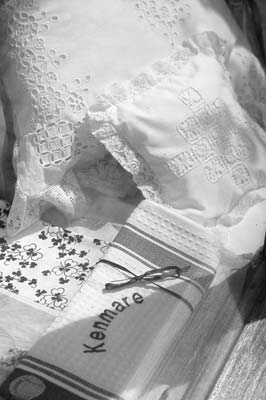
Cost and Hours: Free, May-mid-Oct Mon-Sat 10:00-13:00 & 14:15-17:00, closed mid-Oct-April and Sun year-round, tel. 064/664-2978, mobile 087-234-6998, www.kenmarelace.ie.
Of the 100 stone circles that dot southwest Ireland (Counties Cork and Kerry), this is one of the biggest and most accessible. More than 3,000 years old, it may have been used both as a primitive calendar and as a focal point for rituals. The circle has a diameter of 50 feet and consists of 15 stones ringing a large center boulder (possibly a burial monument). Experts think this stone circle (like most) functioned as a celestial calendar—it tracked the position of the setting sun to determine the two solstices (in June and December), which mark the longest and shortest days of the year.
Cost and Hours: €2, drop coins into honor box in hut by entry when attendant is away, always open.
Getting There: It’s a five-minute walk from the TI. From the city center, face the TI, turn left, and walk 200 yards down Market Street, passing a row of cute 18th-century houses on your right. Beyond the row of houses, veer right through an unmarked modern gate mounted in stone columns, and continue 50 yards down the paved road. You’ll pass the entry hut on your right. The stone circle is behind the adjacent hedge.
Finished in 1864, this is Kenmare’s grand Catholic church. It’s worth visiting to see the ornate wooden ceiling with 10 larger-than-life angels (carved in Germany’s Black Forest), which support the roof beams.
River Valley Riding Stables offers day treks for all levels of experience through beautiful hill scenery in the Roughty River Valley.
Cost and Hours: Adult-€20/hour, child-€15/hour, discounts for groups, open long hours, located about 7 miles east of Kenmare off R-569 near Kilgarvan, tel. 064/668-5360, rivervalleystables@hotmail.com.
Star Sailing rents boats, gives sailing lessons, and organizes hill walks. Hop on a small two-person sailboat (€60 for first hour, €45/ each additional hour) or canoe (€32/hour), or kick around in a kayak (€32/hour). Phone ahead to reserve boats or ask about hikes (daily 10:00-17:00, located 5 miles southwest of Kenmare on R-571 on Beara Peninsula, courtesy shuttle can pick you up in Kenmare, tel. 064/664-1222, www.staroutdoors.ie; adjacent Con’s Restaurant is open daily 12:00-21:00).
Another way to experience Ireland’s 40 shades of green is to splurge on a scenic day on the links. The Kenmare Golf Club is right on the edge of town (€35 greens fee June-Aug, €25 Sept-May, on R-569 toward Cork, tel. 064/664-1291, www.kenmaregolfclub.com). Or try the Ring of Kerry Golf and Country Club (€40 greens fee, 4 miles west of town on N-70, prebook on weekends, tel. 064/664-2000, www.ringofkerrygolf.com).
Wander the compact Kenmare town triangle and stick your head in wherever you hear something you like. Music usually starts at 21:30 (although some pubs have early 18:30 sessions—ask at the TI) and ranges from Irish traditional sessions to sing-along strummers. Crowley’s is an atmospheric little shoebox of a pub with an unpretentious clientele. Foley’s jug-stacked window invites you in for a folksy songfest. The recommended Lansdowne Arms Hotel sponsors live traditional sessions in their Bold Thady Quill Bar.
$$$ Lansdowne Arms Hotel is the town’s venerable grand hotel, with generous public spaces. This centrally located, 200-year-old historic landmark rents 26 large, crisp rooms (Sb-€50-85, Db-€80-150, Tb-€165-225; online discounts, music in pub until late on Fri-Sat, Wi-Fi, parking, corner of Main and Shelbourne Streets, tel. 064/664-1368, www.lansdownearms.com, info@lansdownearms.com).
$$$ Sallyport House, an elegant, quiet house with five rooms filled with antique furniture, has been in Helen Arthur’s family for generations. Ask her to point out the foot-worn doorstep that was salvaged from the local workhouse and built into her stone chimney (Sb-€70-110, Db-€100-140, Tb-€130-160, closed Novmid-March, cash only, no kids, parking, 5-minute walk south of town before crossing Our Lady’s Bridge, tel. 064/664-2066, www.sallyporthouse.com, port@iol.ie).
$$ Hawthorn House is a fine, modern, freestanding house with a lounge, a warm and classy hostess, and 10 comfy rooms sporting fine woodwork courtesy of Mr. O’Brien, who’s also a carpenter. Its quiet residential location is just a block from all the pub and restaurant action (Db-€90-100, Tb-€120-140, Qb-€140, may be cheaper when slow, Wi-Fi, ample parking, Shelbourne Street, tel. 064/664-1035, www.hawthornhousekenmare.com, hawthorn@eircom.net, Mary and Noel O’Brien). Their two modern, self-catering apartments next door work well for those wanting to linger (weekly rentals).
$$ Whispering Pines B&B offers five rooms with sincere, traditional Irish hospitality in a spacious house warmed by the presence of hostesses Mary Fitzgerald and daughter Kathleen (Sb-€45-60, Db-€76-80, Tb-€110, cash only, Wi-Fi, at the edge of town on Bell Height, tel. 064/664-1194, www.whisperingpineskenmare.com, wpines@eircom.net).
$$ Virginia’s Guesthouse, ideally located near the best restaurants, is well kept by Neil and Noreen. Its eight rooms are fresh, roomy, and appealing (Sb-€40-60, Db-€65-90, Tb-€90-130, Wi-Fi, upstairs above Mulcahy’s Restaurant at 36 Henry Street, tel. 086/372-0625, www.virginias-kenmare.com, virginias.guest-house@gmail.com).
$$ Willow Lodge, on the main road at the edge of town, feels American-suburban, with friendly hosts and seven comfortable rooms (Sb-€60-90, Db-€80-100, Tb-€120-150, Qb-€135-150, cash only, Wi-Fi, parking, 100 yards beyond Holy Cross Church, tel. 064/664-2301, www.willowlodgekenmare.com, willowlodgekenmare@yahoo.com, jovial Paul and talkative Gretta GleesonO’Byrne).
$ Limestone Lodge stands rock-solid beside a holy well, with four comfy rooms in a quiet location. Friendly hosts Maria and Siobhan Thomas are experts on Kenmare’s famous lace, and Casey their wiggly Jack Russell terrier is an expert at being cute (Sb-€35-50, Db-€60-70, Tb-€80-99, Qb-€100-132, cash only, Wi-Fi, parking, tel. 064/664-2231, mobile 087-635-4503, www.limestonelodgekenmare.com, info@limestonelodgekenmare.com).
$ Watersedge B&B is a mile south of town, serenely isolated on a forested hillside and overlooking the estuary. The modern house has four clean, colorful rooms and a kid-pleasing backyard (Sb-€40-50, Db-€64-70, Tb-€75-80, cash only, Wi-Fi, parking, tel. 064/664-1707, mobile 087-413-4235, www.watersedgekenmare.com, watersedgekenmare@gmail.com, Noreen and Vincent O’Shea). To get here, drive south over Our Lady’s Bridge, bear left, immediately look for the B&B sign, and take the first right onto the road heading uphill. Go a couple of hundred yards up the paved road, then—at the end of the white cinder-block wall (on left)—turn right onto the gravel lane and drive a hundred yards to the dead-end. It’s worth it.
$ Rockcrest House is secluded down a quiet, leafy lane, with six large rooms and a fine front-porch view (Sb-€35-50, Db-€60-80, Tb-€90-110, cash only, Wi-Fi; as you pass the TI heading north out of town, take the first left after crossing the bridge; tel. 064/664-1248, mobile 087-904-3788, www.visit-kenmare.com, info@visit-kenmare.com, Marian and David O’Dwyer). Ask about their two self-catering cottage rentals.
$ Kenmare Fáilte Hostel (fawl-chuh) maintains 40 budget beds in a well-kept, centrally located building with more charm than most hostels (dorm beds-€18 in rooms without bath, D-€44, Db-€52, T-€60, Tb-€69, Q-€76, Qb-€88, closed mid-Oct-April, Shelbourne Street, tel. 064/664-2333, run by Finnegan’s Corner bike rental folks directly across street, www.kenmare.eu/failtehostel, failtefinn@eircom.net).
$$$ Parknasilla Hotel is a 19th-century luxury hotel lost in 500 plush acres of a subtropical park overlooking the wild Atlantic Ocean. The tranquility, combined with old-fashioned service and Victorian elegance, makes this a good stop for anyone interested in luxuriating on the Ring of Kerry. Originally an old railroad hotel for Romantic Age tourists, in recent decades it has been a ritual splurge for Irish families and wedding groups (Db-€129-159 with breakfast, higher July-Aug, croquet, 19th-century diversions, park walks, see website for details and complex pricing scheme, tel. 064/667-5600, www.parknasillahotel.ie, info@parknasillahotel.ie).
This friendly little town offers plenty of quality choices. If dining, make a reservation or get a table early, as many finer places book up later in the evening during the summer. Pub dinners are a good value and easier on the budget, but pub kitchens close earlier than restaurants.
(See “Kenmare” map, here.)
Soup-and-sandwich lunch options abound. Jam is a handy deli that can make sandwiches or wraps to go for picnics (Mon-Sat 8:00-17:00, Sun 10:00-17:00 except closed Sun Oct-May, Henry Street). The Purple Heather has great salads and omelets (€9-15 meals, Mon-Sat 11:00-17:00, closed Sun, Henry Street, tel. 064/664-1016). Café Mocha is a basic €5 sandwich shop (Mon-Fri 9:00-17:30, Sat-Sun 10:00-17:00, on the town square, tel. 064/664-2133). Murphy’s Daybreak supermarket is a good place to stock up for a Ring of Kerry picnic (Mon-Sat 8:00-22:00, Sun 9:00-21:00, Main Street).
(See “Kenmare” map, here.)
The Lime Tree Restaurant occupies the former Lansdowne Estate office, which gave more than 4,000 people free passage to America in the 1840s. These days, it serves delicious, locally caught seafood dishes in a modern yet cozy dining hall. It’s wise to reserve ahead (€18-27 meals, April-Oct daily 18:30-21:30, closed Nov-March, Shelbourne Street, tel. 064/664-1225).
Packies is a popular bistro that has a leafy, low-light interior and cottage ambience and serves traditional cuisine with French influence. Their seafood gets rave reviews (€23-34 meals, Mon-Sat 18:00-22:00, closed Sun, reservations wise, Henry Street, tel. 064/664-1508).
Mulcahy’s Restaurant has a jazz-mellowed, elegant ambience and creatively presented gourmet dishes. Given the Indian, Japanese, and American influences, there’s always a good vegetarian entrée (€16-26 meals, daily 18:00-22:00, reservations a good idea, 36 Henry Street, tel. 064/664-2383).
Horse Shoe Pub and Restaurant, specializing in steak and spareribs, somehow turns rustic farm-tool decor into a romantic candlelit sanctuary (€17-25 meals, Mon-Fri 12:00-15:00 & 17:00-22:00, Sat-Sun 17:00-22:00, Main Street, tel. 064/664-1553).
P. F. McCarthy’s Pub and Restaurant, which feels like a sloppy saloon, serves reasonable salad or sandwich lunches and filling dinner fare (€15-22 meals, Mon-Sat 10:30-21:00, closed Sun, 14 Main Street, tel. 064/664-1516).
Kenmare has no train station (the nearest is in Killarney, 20 miles away) and only a few bus connections (www.buseireann.ie). Most buses transfer in Killarney.
From Kenmare by Bus to: Killarney (4/day, 45 minutes), Tralee (3/day, 2 hours), Dingle (3/day, 3 hours, change in Killarney), Kinsale (3/day, 3.5-4.25 hours, 2 changes), Dublin (4/day, 6.75-7.75 hours, change in Killarney and Limerick).
These attractions are near Kenmare, at the eastern (inland) end of the Ring of Kerry. If you’re approaching the region from Kinsale and Cobh, drive through Killarney and hop on the Ring to visit Muckross House and Muckross Traditional Farms (near the lakes), Killarney National Park, and Kissane Sheep Farm (in the mountains) en route to Kenmare. By taking a bite out of the Ring the day before you sleep in Kenmare, you’ll be better situated to drive most of the remainder of Ring of Kerry loop the next day. Get an early start from Kenmare and you should be able to avoid the worst of the bus traffic on the Ring.
Killarney is a household word among American tourists, and it seems to be on every big-bus tour itinerary. Springing from the bus and train station of this thriving regional center are a few colorful streets lined with tourist-friendly shops and restaurants. Killarney’s suburbs sprawl with vast hotels that, except for the weather, feel more like Nebraska than Ireland. Killarney’s elegant Neo-Gothic church stands tall, as if to say the town existed and mattered long before tourism. But then you realize it dates from 1880...just about when Romantic Age tourism here peaked. For non-shoppers, Killarney’s value is its location at the doorstep of lush Killarney National Park. And for most tour organizers, it’s the logical jumping-off point for excursions around the famous Ring of Kerry peninsula.
If you’re traveling in the region without a car, you’ll have to stop here. The Killarney bus and train stations flank the big, modern Killarney Outlet Centre mall. (In some touristy parts of Ireland, like this one, every other shopping center is called an “outlet”—implying factory-direct values.) If you have a layover between connections, walk five minutes straight out from the front of the mall, and check out Killarney’s shop-lined High Street and New Street. The TI is a 15-minute walk from the train station, on Beech Street.
From Killarney Around the Ring of Kerry: Bus Éireann drives the loop around the Ring of Kerry from Killarney—suitable for a quick peek. While it generally stops only long enough to pick up and drop off travelers en route, there is a 50-minute stop in Sneem (€23, daily July-mid-Sept, departs the Killarney bus station at 12:45 and returns to Killarney at 17:45, no reservation needed, www.buseireann.ie). You can catch this same bus from Tralee at 11:50, returning to Tralee by 18:45 (€25).
By Bus to: Kenmare (3/day, 45 minutes), Tralee (hourly, 40 minutes), Dingle (4/day, 1.5-2.5 hours, 2 direct, 3 with change in Tralee), Shannon Airport (6/day, 3.5 hours), Dublin (every 2 hours, 6 hours, change in Limerick). The bus station has a left-luggage desk. For bus schedules, call 01/836-6111 or visit www.buseireann.ie.
By Train to: Tralee (8/day, 35 minutes), Cork (every 2 hours, 2 hours, most with change in Mallow), Waterford (5/day, 4-6 hours), Dublin (every 2 hours, 6/day on Sun, 3.5 hours, 1 direct in morning, rest with change in Mallow). For train schedules, call 01/836-6222 or visit www.irishrail.ie.
To Muckross House: There’s no bus service. You can hike 30 minutes (get directions from TI), rent a bike, hire a horse buggy, or catch a cab (€12).
Perhaps the best stately Victorian home you’ll see in the Republic of Ireland, Muckross House (built in 1843 and worth ▲▲) is magnificently set at the edge of Killarney National Park. It’s adjacent to Muckross Farms, a fascinating open-air farm museum that shows rural life in the 1930s (worth ▲). Besides the mansion and farms, this regular stop on the tour-bus circuit also includes a fine garden idyllically set on a lake and an information center for the national park. The poignant juxtaposition of the magnificent mansion and the humble farmhouses illustrates in a thought-provoking way the vast gap that once separated rich and poor in Ireland.
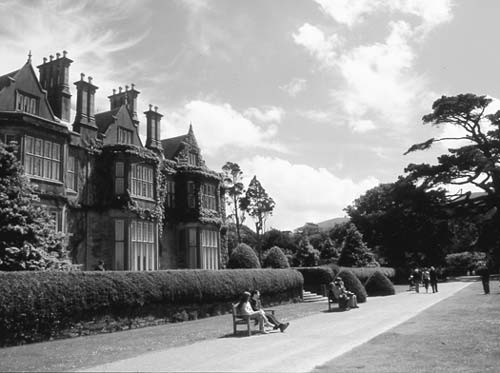
Cost and Hours: House-€7.50, farms-€7.50, €12.50 combo-ticket includes both (Heritage Cards not accepted for farms). House open daily 9:00-17:30, July-Aug until 19:00, shorter hours in winter, last entry one hour before closing. Farms open daily June-Aug 10:00-19:00, May and Sept daily 13:00-18:00, mid-March-April and Oct Sat-Sun only 13:00-18:00, closed Nov-mid-March, tel. 064/667-0144.
Tours: The only way to see the interior of the house is with the 45-minute guided tour, which gives meaning to your visit (included with admission, offered frequently throughout the day). Book your tour as soon as you arrive (they can fill up). Then enjoy a walk in the gardens or lunch in their better-than-average cafeteria until your tour begins.
Getting There: Muckross House is conveniently located for a break on the long ride from Kinsale or Cashel to Dingle or Kenmare. From Killarney, follow signs to Kenmare, where you’ll find Muckross House three miles (5 km) south of town. As you approach from Killarney, you’ll see a small parking lot two miles before the actual parking lot. This is used by horse-and-buggy bandits to hoodwink tourists into thinking they have to pay to clip-clop to the house. Giddy-up on by to find a big, safe, and free parking lot right at the mansion.
Visiting the House and Farms: A visit to Muckross House takes you back to the Victorian period—the 19th-century boom time, when the sun never set on the British Empire and the Industrial Revolution (born in England) was chugging the world into the modern age. Of course, Ireland was a colony back then, with big-shot English landlords. During the Great Potato Famine of 1845-1849, most English gentry lived very well—profiting off the export of their handsome crops to lands with greater buying power—while a third of Ireland’s population starved.
Muckross House feels lived-in (and it was, until 1933). Its fine Victorian furniture is cluttered around the fireplace under Waterford crystal chandeliers and lots of antlers. You’ll see Queen Victoria’s bedroom (ground floor, since she was afraid of house fires). The owners of the house spent a couple of years preparing for the royal visit in 1861, eager to gain coveted titles and nearly bankrupting themselves in the process. The queen stayed only three nights and her beloved Prince Albert died soon after the visit. The depressed queen never granted the titles that the grand house’s owners had so hoped for.
The house exit takes you through an information center for Killarney National Park, with a relaxing 15-minute video on “Ireland’s premier national park,” featuring lots of geology, flora, and fauna (free, shown on request).
The garden is a hit for those with a green thumb, and a €1.50 booklet makes the nature trails interesting. A bright, modern cafeteria (with indoor/outdoor seating) faces the garden. The adjacent crafts shop shows weaving and pottery-making in action.
The Muckross Traditional Farms consists of six different vintage farmhouses. The farms are strung along a mile-long road, with an old bus shuttling those who don’t want to hike (free, 4/hour).
For those interested in Irish farm life from the 1920s until electricity arrived in 1955, this is a great experience—but only if you engage the attendants in conversation. Each farm is staffed by a Kerry local who enjoys telling tales of life on the farm in the old days. When they first got electricity in 1955, they’d pull on their rubber Wellington boots for safety and nervously “switch it on.” Poor farmers could afford electricity only with the help of money from relatives in America. They’d have one bulb hanging from the ceiling and, later, one plug for a hot pot. Every table had a Sacred Heart of Jesus shrine above it. The plug went directly below it. No one dreamed of actually heating the house with electricity. Children slept six to a bed, “three up and three down...feet in your face.” You’ll learn what happened when you had the only radio in the area, and how one flagstone on the mud floor was enough for the fiddler and dancer to set the beat. Probe with your questions...get personal.
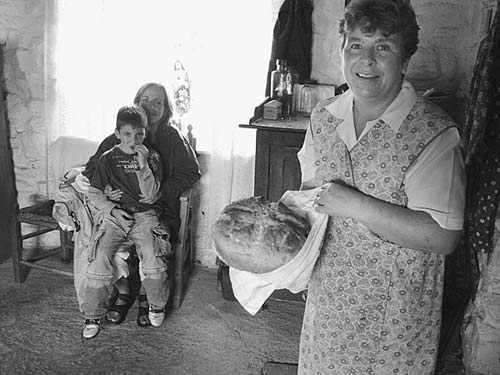
As you drive from Killarney to Kenmare, heading south on N-71, you’ll sweep through scenic Killarney National Park (just south of Killarney town) on the most mountainous stretch of the Ring of Kerry. This 25,000-acre park (Ireland’s oldest) was established when Muckross Estate was donated to the nation in 1932. Glacially sculpted rock ridges cradle three large lakes teaming with trout and salmon that lure sport fishermen.
Hikers enjoy an easy 10-minute stroll along a mossy trail from the roadside up to Torc Waterfall (look for small parking lot beside N-71, 2 miles—3 km—south of Muckross House), then lace up their boots to take on more strenuous trails beyond. If you go early or late in the day, keep an eye out for Ireland’s only native herd of red deer. The park’s old-growth oak, yew, and alder groves are the best preserved in Ireland, and rhododendrons explode beside the road in late May and June.
Enjoy expansive lake views from Ladies View, right beside the N-71 road, half a mile (1 km) from the park’s southern exit.
Just south of the park exit, you’ll pass long thin Looscaunagh Lough (beside the road on the left). A few hundred yards farther, the Black Valley opens up beneath you on the right. This remote valley was the last chunk of Ireland to get electricity—in 1978. The highest bump on the distant ridge across the Black Valley to the west is Carrauntoohil, Ireland’s tallest mountain at 3,400 feet.
Animal lovers will enjoy an hour’s visit to this hardworking 2,500-acre Irish farm, perched on a scenic slope above the Black Valley. John Kissane, whose family has raised sheep here for five generations, gives hands-on demonstrations of sheep shearing. John (or his brother Noel) explains the process and invites you to touch the pile of fresh wool afterward. You can feel the lanolin, which acts as natural waterproofing for the sheep and is extracted from the wool to sell to pharmaceutical firms (synthetic manufacturing has driven the price of wool so low, it’s not worth selling otherwise). But the highlight of any visit is the demonstration of sheepherding by the highly alert family dogs (border collies trained here since puppyhood). John commands the dogs from afar using an array of verbal calls and hand signals.
Note that this is a working farm—demonstration times fluctuate depending on necessary farm work. Call ahead for times (usually in the afternoon), or check the current schedule on their website, under “Sheep Dog Demonstration Calendar.”
Cost and Hours: €7, most afternoons June-Aug, April-May and Sept by appointment only (minimum 15 people), closed Oct-March, on N-71 between Ladies View and Moll’s Gap, tel. 064/663-4791, mobile 087/260-0410, noel@kissanesheepfarm.com, www.kissanesheepfarm.com.
From Kissane Sheep Farm to Kenmare: Continue driving south on N-71. Going over Moll’s Gap (WCs and Avoca Café beside parking lot), you’ll descend into Kenmare. The rugged, bare rock on either side of the road was rounded and smoothed by the grinding action of glaciers over thousands of years. In the distance to the north (on your right) you can see the Gap of Dunloe, a perfect example of a U-shaped glacial valley notch.
The Ring of Kerry (the Iveragh Peninsula) has been the perennial breadwinner of Irish tourism for decades now. Lassoed by a winding coastal road (the Ring), this mountainous, lake-splattered region comes with breathtaking scenery and the highest peak in Ireland. While a veritable fleet of big, tourist-laden buses circles it each day, they generally stay together and seem to stop at the same handful of attractions. Therefore, if you avoid those places at rush hour, the Ring feels remarkably un-spoiled and dramatically isolated. Clever motorists, armed with a good map and a reliable alarm clock, can sidestep the crowds and enjoy one of the most rewarding days in Ireland.
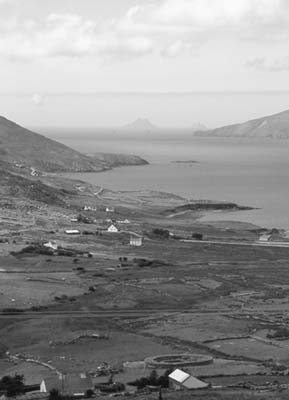
More than twice the size of the Dingle Peninsula (see next chapter) and backed by a muscular tourism budget that promotes every sight as a “must-see,” the Iveragh Peninsula can seem overwhelming. Be selective, and don’t let them pull the turf over your eyes.
By Car: You can explore the Ring (primarily on N-70) in one satisfying day. Travelers linking overnights in Kinsale and Dingle can insert a night between them in Kenmare (a good base for enjoying the best of the Ring of Kerry). If visiting Muckross House and Kissane Sheep Farm (on the mountainous section of the Ring of Kerry), do so in the afternoon before arriving in Kenmare, to save all of the following day for the rest of the Ring.
Tackling the Kinsale-to-Dingle drive plus the Ring of Kerry all in the same day is doable with an early start (no later than 8:30)—but you add about two hours of driving just to reach the actual Ring, meaning you have little time to stop and enjoy what you came here to see. You also run the risk of meeting the big-bus convoy head on (see “Driving the Ring of Kerry,” below).
If you’re considering a boat trip out to the desperately remote and evocative island of Skellig Michael, you’ll need to add another day to allow for an overnight in the Portmagee area...and hope for good weather.
By Public Transportation: You have three options for seeing the Ring of Kerry without a car, none of which is as enjoyable as driving the loop yourself: minibus tour from Kenmare (see here); big-bus tour from Killarney (TI tel. 064/663-1633); or public bus from Killarney (see here).
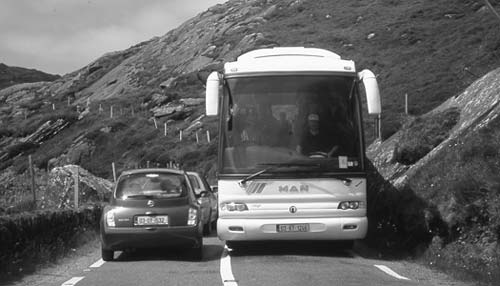
On a one-day visit to the Ring, I’d leave Kenmare by 8:30 and head clockwise (against the prevailing tour-bus traffic). Allow time for stops at Staigue Ring Fort (45 minutes) and Derrynane House (1 hour), and get to Waterville before noon. To entirely miss the chain of tour buses, which slithers (like a python swallowing a pig) counterclockwise around the Ring, get to Waterville by 11:00; shortly after that, leave the main drag for the Skellig Ring (with a road that’s too narrow for big buses). Plan to have lunch out on the Skellig Ring, either as a picnic on the lovely beach at St. Finian’s Bay, or in Portmagee. By the time you rejoin the main route, the python has slunk by. On the last half of the route, there are two more hour-long stops: the Skellig Experience Centre (near Portmagee) and two additional big ring forts (near Cahersiveen). For a stop-by-stop description of this route, see my self-guided driving tour, later.
The only downside of going against all the bus traffic is that, on the narrow parts of the Ring road, buses always have the right-of-way. It’s up to you to back up to the nearest wide spot in the road to let a less-nimble bus get through a tight curve. But every year I notice that the road has been improved and bottlenecks widened. There are also lots of scenic-view pullouts. With an early start, you can avoid these hassles: On my last circuit, I got to Waterville by 11:30, from where I slipped happily into the bus-free Skellig Ring...and didn’t have to pass a single bus all day.
Smart drivers equip themselves with a good map before driving the Ring of Kerry loop. If you don’t have one already, pick up the Complete Road Atlas of Ireland by Ordnance Survey (€10, sold in most TIs and bookstores in Ireland). The Fir Tree Aerial series provides a useful map that covers both the Iveragh (Ring of Kerry) and Dingle Peninsulas, giving you a bird’s-eye feel for the terrain (€7, sold in many TIs and bookstores in County Kerry).
The flat, inland, northeastern section of the Ring, from Killorglin to Killarney on N-72, is entirely skippable. Tank up before leaving, as gas in Kenmare is cheaper than out on the Ring.
Here’s a sightseeing tip sheet for my preferred clockwise route, kilometer by kilometer. If you do any exploring, you’ll likely get hopelessly off pace, but the kilometer references still help—just do the arithmetic to figure out how far various stops are from each other. Several of these stops are explained in far greater detail later in this chapter, in the same order in which they’re listed here. To understand your options, read the rest of this chapter before you start on your tour.
0 km: Leave Kenmare.
17.6 km: On the right is Glacier Lake, with a long, smooth limestone “banister” carved by a glacier 10,000 years ago.
22.8 km: The recommended Parknasilla Hotel—a posh 19th-century hotel—is a great stop for tea and scones.
26 km: Visit the town of Sneem.
40.4 km: Turn off for the Staigue Ring Fort.
41.5 km: On the left, enjoy great views of the Beara Peninsula beyond a ruined hospital with IRA ties (it was funded about 1910 by a local Englishwoman sympathetic to the Irish Republican cause). No one wants to touch these ruins today, out of fear of “kicking up a beehive.”
43.5 km: Carroll’s Cove has a fine beach with some of the warmest water in Ireland, grand views of Kenmare Bay, a local trailer park, and “Ireland’s only beachside bar.”
46.4 km: Take the turnoff for Derrynane House (home of Daniel O’Connell).
50.4 km: Enjoy brilliant views for the next two kilometers to Coomakesta Pass.
52.4 km: The Coomakesta Pass lookout point (700-foot altitude) offers grand vistas in both directions.
54.5 km: Watch for fine views of the Skellig Islands.
56.4 km: Notice the ruins of famine villages on both sides of the road.
59.6 km: In the town of Waterville, you’ll see a sculpture of Charlie Chaplin on the left. Waterville is also home to the Butler Arms Hotel—a fine stop for tea and scones in its Charlie Chaplin room (with lots of photos of the silent-film icon and his young wife frolicking as they lived well in Ireland).
65 km: After rejoining the main road and turning left, cross the small bridge that’s locally famous for salmon fly-fishing. Take the first left (R-567) for the Skellig Ring loop (follow brown Skellig Ring signs through Ballinskelligs, and then scenically to Portmagee). At this point, you’ve left the big-bus route.
75 km: St. Finian’s Bay lies about halfway around, with a pleasant little picnic-friendly beach that’s recently been discovered by surfers (no WCs). Just before the bay is the small, modern Skelligs Chocolate Factory, with free, tasty samples as well as a café for coffee and muffins (Mon-Fri 10:00-17:00, Sat-Sun 12:00-17:00, especially fun for kids, tel. 066/947-9119, www.skelligschocolate.com).
80 km: Photographers and walkers will want to turn left into the driveway that advertises “Best View in County Kerry.” Park and pay the €4 fee at the B&B reception. Then walk 10 minutes straight up the gravel road, where you’ll be confronted by a dramatic coastal cliff that opens up onto what may indeed be the best view in County Kerry. The beehive huts nearby are replicas but true to the originals.
83 km: You reach Portmagee, a small port town and jumping-off point for boats to the Skellig Islands.
83.2 km: Cross the bridge to the Skellig Experience Centre. You’re now on Valentia Island, its name hinting at medieval trading connections with nearby Spain—which lies due south. Dinosaur hunters may want to detour and follow the signs to the modest but ancient tetrapod tracks, frozen in stone, on the north side of the island.
91.2 km: At the church in Knightstown, turn left for the Knightstown Heritage Museum.
93 km: Return to the main road and go through Knightstown to the tiny ferry (€6/car, runs constantly 8:00-21:00, 2-km trip).
95 km: Leaving the ferry, rejoin N-70 (the main Ring of Kerry route), turning left for the town of Cahersiveen. From here, you can detour a few kilometers to two impressive stone ring forts, Cahergal and Leacanabuaile.
100 km: Return to N-70 at Cahersiveen and follow signs for Glenbeigh and Killorglin. Enjoy views of the Dingle Peninsula across Dingle Bay to your left (you can see the harbor and Ersk Tower) and Inch Beach.
The rest of the loop is less scenic. At Killorglin, you’ve seen all there is to see. From here, go either to Dingle (left) or to Kenmare/ Killarney/Kinsale (right).
Sneem is inundated by tour buses daily from 14:00 to 16:00. The rest of the day, Sneem is peaceful and laid-back. This humble town has two entertaining squares. The Irish joke, “As we’re in Kerry, the square on the east side is called South Square and the one on the west is called North Square.” On the first (South) square, you’ll see a statue of Steve “Crusher” Casey, the local boy who reigned as world champion heavyweight wrestler (1938-1947). A sweet little peat-toned waterfall gurgles under the one-lane bridge connecting the two Sneem squares. The North Square features a memorial to former French president Charles de Gaulle’s visit (Irish on his mother’s side, de Gaulle came here for two weeks of R&R after his final retirement from office in 1969). Locals call it “da gallstone.”
This ring fort is worth a stop on your way around the Ring (always open, drop €1 in the little gray donation box beside the gate). While viewing the imposing pile of stone, read “The Ring Forts of Kerry” sidebar, earlier.
Getting There: The fort is 2.5 miles (4 km) off the main N-70 road up a narrow rural access lane (look for signs just after the hamlet of Castle Cove). Honk on blind corners to warn oncoming traffic as you drive up the hedge-lined lane.
This is the home of Daniel O’Connell, Ireland’s most influential pre-independence politician, whose tireless nonviolent agitation gained equality for Catholics 185 years ago. The coastal lands of the O’Connell estate that surround Derrynane House are now a national historic park. A visit here is a window into the life of a man who not only liberated Ireland from the last oppressive anti-Catholic penal laws, but also first developed the idea of a grassroots movement—organizing on a massive scale to achieve political ends without bloodshed (see sidebar).
Cost and Hours: €3; May-Sept daily 10:30-18:00; April and Oct Wed-Sun 10:30-17:00, closed Mon-Tue; closed Nov-March, last entry 45 minutes before closing, tel. 066/947-5113.
Getting There: Just outside the town of Derrynane, pick up a handy free map of the area from the little private TI inside the brown Wave Crest market (TI open daily May-Sept 9:00-18:00, closed Oct-April, tel. 066/947-5188; market is a great place to buy picnic food). One mile after the market, take a left and follow the signs into Derrynane National Historic Park.
Visiting the House: Navigate the house’s quirky floor plan with the €0.50 guide available at the front desk. Ask about the next scheduled 20-minute audiovisual show, which fleshes out the highlights of O’Connell’s turbulent life and makes the contents of the house more interesting.
In the exhibition room downstairs is a glass case containing the pistols used in O’Connell’s famous duel. Beside them are his black gloves, one of which he always wore on his right hand when he went to Mass (out of remorse for the part it played in taking a man’s life). The drawing room upstairs is lined with family portraits and contains his ornately carved chair with tiny harp strings and wolfhound collars made of gold. On a wall in the upstairs bedroom is a copy of O’Connell’s celebrated speech imploring the Irish not to riot when he was arrested.
The coach house (out back) shows off the enormous grand chariot that carried O’Connell through throngs of joyous Dubliners after his release from prison in 1844. He added the small chapel wing to the house in gratitude to God for his prison release.
Just a short row of snoozy buildings lining the bay, Portmagee is the best harbor for boat excursions out to the Skellig Islands (see “Getting There” on here). It’s a quiet village with a handful of B&Bs, two pubs, a bakery, a market, and no ATMs—the closest ATM is 6 miles (10 km) east in Cahersiveen. On the rough harborfront, a slate memorial to sailors lost at sea from here reads, “In the nets of God may we be gathered.”
A 100-yard-long bridge connects Portmagee to gentle Valentia Island, where you’ll find the Skellig Experience Centre (on the left at the Valentia end of the bridge). A public parking lot is at the Portmagee end of the bridge, with award-winning WCs (no kidding: look for the proudly displayed “Irish Toilet of the Year 2002 runner-up” plaque). The first permanent transatlantic cable (for telegraph communication) was laid from Valentia Island in 1866. The tiny post office hides inside O’Connell’s Market (both open Mon-Fri 9:00-17:30, Sat 9:00-13:00, closed Sun).
Sleeping in Portmagee: The first two listings are in town. The last listing is south of Portmagee, on St. Finian’s Bay.
$$$ Moorings Guest House feels like a small hotel, with 17 rooms, a pub and a fine restaurant downstairs, and the most convenient location in town, 50 yards from the end of the pier (Sb-€57-70, Db-€69-140, Tb-€99-145, Qb-€140-190, tel. 066/947-7108, www.moorings.ie, moorings@iol.ie, Gerard and Patricia Kennedy).
$$ Portmagee Heights B&B is a modern, solid slate home at the edge of town, renting eight hotel-like rooms (Db-€70-80, Tb-€105-120, Wi-Fi, on the road into town, tel. 066/947-7251, www.portmageeheights.com, portmageeheights@gmail.com, hostess Monica Hussey can arrange Skellig boat trips). They also have a cool self-catering cottage across the road—great for families who want some space to themselves.
$ Beach Cove B&B offers three comfortable, fresh, and lovingly decorated rooms in splendid isolation four miles south of Portmagee, over lofty Coomanaspic ridge, beside the pretty beach at St. Finian’s Bay (100 yards past the Skelligs Chocolate Factory). Charming Bridie O’Connor will arrange a boat trip out to the Skelligs for you. Her adjacent cottage out back has two double rooms, making it ideal for families (Sb-€45-50, Db-€65-70, Tb-€95, family room-€100, tel. 066/947-9301, mobile 087-139-0224, www.stayatbeachcove.com, beachcove@eircom.net). Bridie’s husband, Jack, was the head coach of the Kerry football team until he retired in 2012...making him a very important person in this part of Ireland (Kerry has won more football titles than any other Irish county, three of them with Jack at the helm).
Eating in Portmagee: These options all line the waterfront (between the pier and the bridge to Valentia Island). The Moorings is a nice restaurant with great seafood caught literally just outside its front door (€16-22 dinners, Tue-Sun 18:00-22:00, closed Mon, reservations a good idea, tel. 066/947-7108, www.moorings.ie). The Bridge Bar, next door, does traditional pub grub but stops serving food a bit early. Call ahead to check on their traditional music and dance schedule (€10-18 meals, daily 10:00-20:30, live music Fri and Sun nights, tel. 066/947-7108). The Fisherman’s Bar is less flashy, with more locals and cheaper prices (€10-19 meals, daily 10:00-21:00, tel. 066/947-7103).
For picnic supplies, O’Connell’s Market is the only grocery (Mon-Sat 9:00-20:00, Sun 9:30-15:30). Skellig Mist Bakery can make basic lunch sandwiches to take on Skellig boat excursions (daily 9:30-17:30, tel. 066/947-7250).
These two sights are on Valentia Island, across the bridge from Portmagee.
Whether or not you’re actually sailing to Skellig Michael (described later), this little center (with basic exhibits and a fine 15-minute film) explains it well—both the story of the monks and the natural environment.
Cost and Hours: €5, daily July-Aug 10:00-19:00, until 18:00 in spring and fall, closed mid-Nov-mid-March, last entry one hour before closing, call ahead outside of peak season as hours may vary, on Valentia Island beside bridge linking it to Portmagee, tel. 066/947-6306, www.skelligexperience.com.
Boat Trips: The Skellig Experience Centre arranges two-hour boat trips, circling both Skellig Michael and Little Skellig (without actually bringing people ashore)—ideal for those who want a close look without the stair climb and vertigo that go with a visit to the island (€27.50, sailing daily about 14:45 and returning by 17:00, weather permitting, depart from Valentia Island pier 50 yards below the Skellig Experience Centre).
The humble Knightstown schoolhouse, built in 1861, houses an equally humble but interesting little museum highlighting the quirky things of historic interest on Valentia Island. You’ll see a 19th-century schoolroom and learn about tetrapods (those first fish to climb onto land—which locals claim happened here). You’ll also follow the long story of the expensive, frustrating, and heroic battle to lay telegraph cable across the Atlantic, which—after some false starts—finally succeeded in 1866, when the largest ship in the world connected this tiny island of Valentia with Newfoundland. This project was the initiative of the Atlantic Telegraph Company, which later became Western Union. These stories and more are told with intimate black-and-white photos and typewritten pages.
Cost and Hours: €3.50, daily April-Sept 11:00-17:00, closed Oct-March, tel. 066/947-6411, www.vhc.cablehistory.org.
Nearby: If you are interested in those tetrapods, the actual “first footprints” are a 15-minute drive from the museum, on a rugged bit of rocky shoreline, a 10-minute hike below a parking lot (free, always viewable, get details locally).
Crowning bluffs in farm country, 2.5 miles (4 km) off the main road at Cahersiveen, these two windy and desolate forts are each different and worth a look. Just beyond the Cahersiveen town church at the tourist office, turn left, cross the narrow bridge, turn left again, and follow signs to the ancient forts—you’ll see the huge stone structures in the distance. You’ll hike 10 minutes from the tiny parking lot (free, always open, no museum). Both forts are roughly 100 yards off the road (uphill on the right) and are 200 yards from each other. For details, see “The Ring Forts of Kerry” sidebar, earlier.
A trip to this jagged, isolated pyramid—the Holy Grail of Irish monastic island settlements—rates as a truly memorable ▲▲▲ experience. After visiting Skellig Michael a hundred years ago, Nobel Prize-winning Irish playwright George Bernard Shaw called it “the most fantastic and impossible rock in the world.”
Rising seven miles offshore, the Skelligs (Gaelic for “splinter”) are two gigantic slate-and-sandstone rocks crouched aggressively on the ocean horizon. The larger of the two, Skellig Michael, is more than 700 feet tall and a mile around, with a tiny cluster of abandoned beehive huts clinging near its summit like stubborn barnacles. The smaller island, Little Skellig, is home to a huge colony of gannet birds (like large, graceful seagulls with six-foot wingspans), protected by law from visitors setting foot onshore.
Skellig Michael (dedicated to the archangel) was first inhabited by sixth-century Christian monks. Inspired by earlier hermit-monks in the Egyptian desert, they sought the purity of isolation to get closer to God. Neither Viking raids nor winter storms could dislodge them, as they patiently built a half-dozen small, stone, igloolike dwellings and a couple of tiny oratories. Their remote cliff-terrace perch is still connected to the sea 600 feet below by an amazing series of rock stairs. Viking Olav Trygvasson, who later became king of Norway and introduced Christianity to his country, was baptized here in 956.
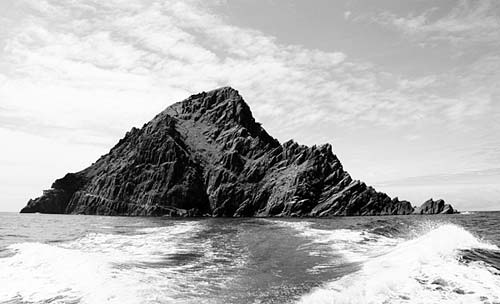
Chiseling the most rudimentary life from solid rock, the monks lived a harsh, lonely, disciplined existence here, their colony surviving for more than 500 years. They collected rainwater in cisterns and lived off fish and birds. To supplement their meager existence, they traded bird eggs and feathers with passing boats for cereals, candles, and animal hides (used for clothing and for copying scripture). They finally moved their holy community ashore to Ballinskelligs in the early 1100s. But Christian pilgrims continued to visit Skellig Michael for centuries as penance...edging out onto a ledge to kiss a stone cross that has since toppled into the ocean.
To book a boat trip from Portmagee, contact Murphy Sea Cruise (€45, April-Oct, mobile 087-676-2983, 087-234-2168, or 087-645-1909, www.esatclear.ie/~skelligsrock, murphyseacruise@esatclear. ie), Joe Roddy (mobile 087-284-4460, www.skelligstrips.com), Brendan Casey (tel. 066/947-2437, mobile 087-228-7519), or Des Lavelle (tel. 066/947-6124, mobile 087-237-1017).
Boat trips normally depart Portmagee at 10:00 (depending on tides), sail for an hour, leave you on the island from roughly 11:00 until 13:30, and get you back into Portmagee by 14:30 (with plenty of time to drive on to Dingle). Fifteen small boats (from Portmagee, Ballinskelligs, Waterville, and Valentia Island) have permits to land on Skellig Michael. Each boat can carry a dozen passengers. This limits the number of daily visitors and minimizes the impact on the sensitive island ecosystem.
Bring your camera, a sandwich lunch (easy to buy at the recommended Skellig Mist Bakery in Portmagee), water, sunscreen, rain gear, hiking shoes, and your sense of wonder.
Weather Warning: Landing on Skellig Michael is highly weather-dependent. If the seas are too choppy, the boats cannot safely drop people at the concrete island pier (it’s a bit like jumping off a trampoline onto an ice rink). Excursions are scheduled to run daily from Easter to late September, but experienced boat captains say they are able to bring visitors ashore roughly five days out of seven in an average summer week.
Your best bet is to reserve a room near Portmagee or St. Finian’s Bay—whichever best fits your itinerary. (It’s possible to sleep in Kenmare and get up early to drive two hours straight to Portmagee—but you’ll be frustrated by not having time to enjoy the Ring’s attractions along the way). Then call a few days in advance to make a boat reservation. Keep your fingers crossed for good weather. Contact the boat operator on the morning of departure to get the final word. If the seas are too rough, he can tell from Portmagee and will make a decision that morning whether to go (rather than taking passengers halfway out, then aborting).
Since you’ll have only 2.5 hours to explore the island, begin by climbing the seemingly unending series of stone stairs to the monastic ruins (600 vertical feet of uneven steps with no handrails). Save most of your photographing for the way down. Those who linger too long below risk missing the enlightening 20-minute free talk among the beehive huts, given by guides who camp on the island from April through October. Afterward, poke your head into some of the huts and try to imagine the dark, damp, and devoted life of a monk here more than 1,000 years ago. After rambling through the ruins, you can give in to photo frenzy as you wander back down the stairs.
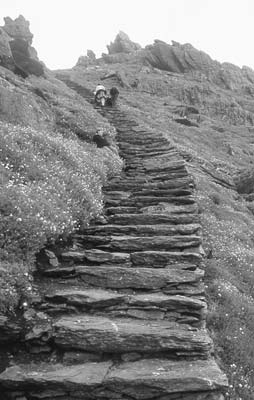
The two lighthouses on the far side of the island are now automated, and access to them has been blocked off. There are no WCs or modern shelters of any kind on Skellig Michael.
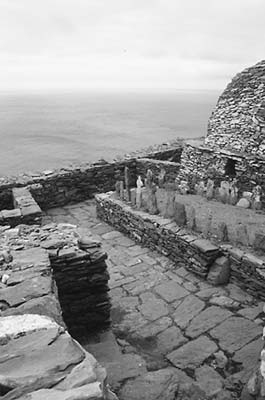
If you visit between late April and early August, you’ll be surrounded by fearless rainbow-beaked puffins, which nest here in underground burrows. Their bizarre swallowed cooing sounds like a distant chainsaw. These portly little birds live off fish, and divers have reported seeing them 20 feet underwater in pursuit of their prey.
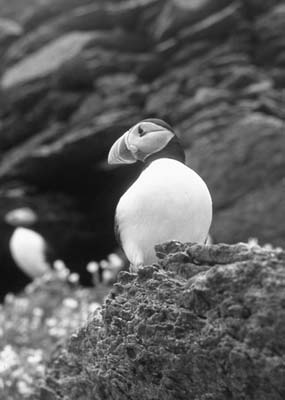
Your return boat journey usually includes a pass near Little Skellig, which looms like an iceberg with a white coat of guano—courtesy of the 20,000 gannets that circle overhead like feathered confetti. These large birds suddenly morph into sleek darts when pursuing a fish, piercing the water from more than 100 feet above. You’re also likely to get a glimpse of gray seals lazing on rocks near the water’s edge.